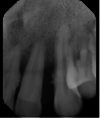Gingival Overgrowth in an Adult Male Patient
- PMID: 35371828
- PMCID: PMC8958140
- DOI: 10.7759/cureus.22572
Gingival Overgrowth in an Adult Male Patient
Abstract
Pyogenic granuloma (PG) is an oral reactive inflammatory hyperplasia of connective tissue that can occur in response to hormonal changes and local irritation such as calculus, fractured teeth, rough dental restorations, and foreign materials. It is nonneoplastic and predominant in the second decade of life in young adult females. The most common site of involvement is the gingiva. Lesions are more common in the maxillary than mandibular gingiva and mainly occur on the facial or buccal aspect. Pyogenic granuloma rarely grows more than 2 cm in diameter and is rarely associated with bone loss. This article presents a rare case of an abnormally large pyogenic granuloma affecting both the labial and palatal gingiva sustaining occlusal trauma due to its size and associated with severe alveolar bone loss that was managed successfully with surgical excision in a 40-year-old male.
Keywords: bone loss; exophytic nodule; gingival overgrowth; pyogenic granuloma; reactive benign lesion.
Copyright © 2022, Mahajan et al.
Conflict of interest statement
The authors have declared financial relationships, which are detailed in the next section.
Figures





References
-
- Kerr AR, Phelan JA. Burket's Oral Medicine. Hamilton, Ontario: BC Decker Inc; 2008. Benign lesions of the oral cavity; pp. 129–152.
Publication types
LinkOut - more resources
Full Text Sources
